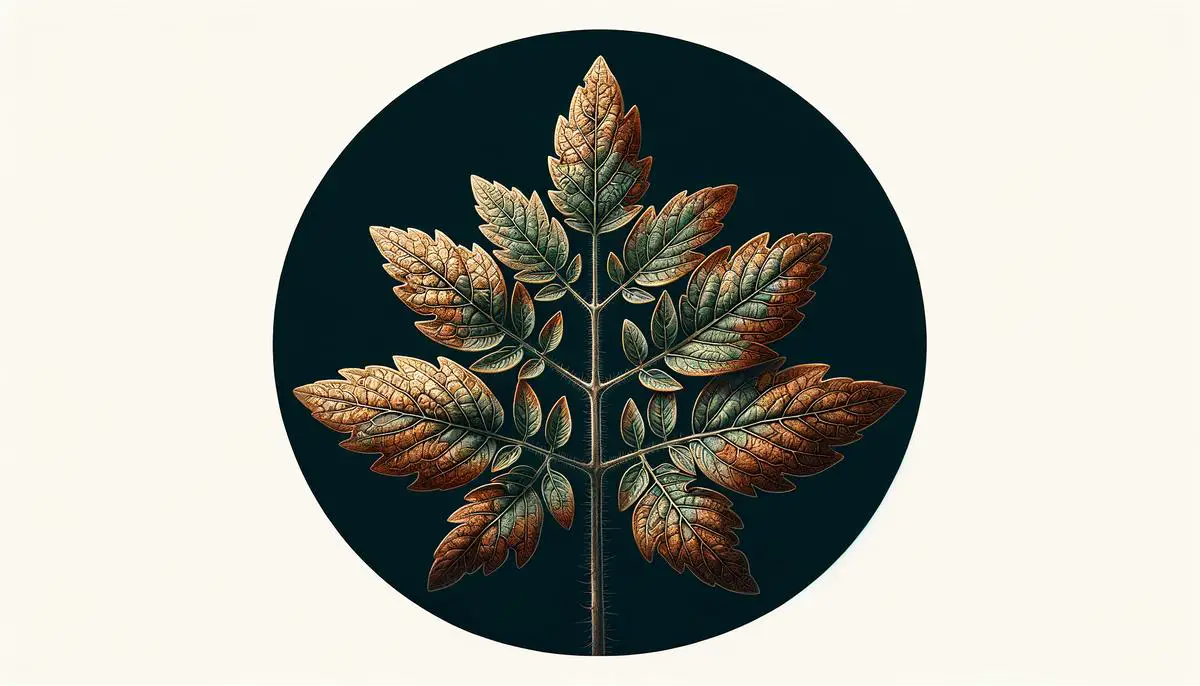Reviving Brown-Edged Tomato Leaves: Causes and Solutions

Hey there, fellow green thumbs and garden enthusiasts! Today, we’re tackling a common but puzzling problem that many of us face in our gardens – those pesky brown edges on tomato plant leaves. It’s a situation that can leave even the most experienced gardener scratching their head. But worry not, because we’re about to get to the bottom of this. Together, we’ll explore some of the main culprits behind this issue and share tips on how to keep your tomato plants healthy and thriving.
Identifying Causes of Brown Edges
Hey my green-thumbed friends! Today, I’m diving into a topic that’s caused me more than a few gray hairs – why on Earth are my tomato plant leaves turning brown? If you’ve been nodding your head in agreement, don’t fret, you’re not alone. Let’s roll up our sleeves and uncover this mystery together, shall we?
- Water Woes: First thing’s first, let’s talk about water – too much or too little? Our tomato babies are super picky. They need just-right Goldilocks watering. Too little, and they’ll be shriveling up faster than my skin sans moisturizer. Too much, and you’ve got yourself a recipe for root rot. The key? That soil should feel like a wrung-out sponge – moist but not soggy.
- Sunburn, Yes, Plants Get It Too: Picture this: your tomatoes are basking in the sun, perhaps a bit too much. Tomatoes love the sunshine, don’t get me wrong, but too much direct exposure in the scorching heat can give them a nasty sunburn. If those top leaves are looking crispier than my homemade bacon, consider some afternoon shade.
- Nutrient Deficit – Time for a Health Check: Just like us, without the right nutrients, our plant pals start looking a bit rough around the edges. If you’ve got yellowing leaves that progress to brown with a little purpling thrown in? Holler at calcium and magnesium. Mix in some bone meal or Epsom salts into that soil and watch your tomatoes turn into the lush, green beauties they were meant to be.
- Fungi Amongi – Battling Blights and Spots: If your tomato plants are showcasing a rather unattractive array of spots before going full-on chocolate brown leaf mode, you’ve invited fungi to the party. Septoria leaf spot and early blight are the culprits often. Fear not! Removing affected leaves and keeping that foliage dry is your first line of defense. Also, a friendly reminder: crop rotation is key. Give those spores a surprise by switching up their growing spot next season.
- Pesky Pests – The Unwanted Guests: Look closer, my dear Watson. See those tiny critters? Spider mites and aphids love to suck the life out of your plants, quite literally, leading to browning leaves. A quick fix can be as simple as introducing ladybugs (yes, they dine on mites like it’s their job) or spraying down with a neem oil solution.
There you have it, pals! Solving the mystery of brown tomato leaves might require a bit of detective work and patience, but fear not, you’ve got this in the bag. Remember, it’s all about observance and love – treat your plants like you do your little ones (or in my case, my crazy boys). Notice changes, act swiftly, and keep those green babies thriving.
Hoping this guide lights the way to happier, healthier tomato plants in your garden. Until next time, keep those thumbs green and spirits high!

Proper Watering Techniques
Gardening may seem like a never-ending adventure, kinda like being a mom to three rambunctious boys, am I right? Just when you think you’ve got it all figured out, your tomatoes throw you a curveball. So, let’s dive into the heart of the matter: how to water your tomato plants for that lush, bountiful harvest you’ve been dreaming of. And trust me, it’s not as daunting as it seems—though, as with boys, expect the unexpected!
First things first, timing is everything. Picture this: early morning, coffee in hand, the world’s still quiet—this is your prime time to water those plants. Why, you might wonder? Well, watering in the morning gives your plants a chance to drink up before the midday sun can evaporate the moisture. It’s like making sure your kids have a hearty breakfast before they tackle the day—a solid start makes all the difference.
Now on to the next big question: How much water? This part reminds me of Goldilocks—you gotta get it just right. Too little and your plants are left feeling parched and forgotten, but too much, and you’re dealing with waterlogged roots that could spell disaster. A general rule of thumb? Aim for about 1-2 inches (2.5-5 cm) of water per week, including rainwater. Think of it as ensuring your plants are staying hydrated, much like keeping those sports bottles filled for your kids’ endless activities.
But here’s where it might get a touch tricky. Not all soil is born equal. Imagine this: some soil is like that super-absorbent towel, holding onto moisture for days. Other soil? It’s more like that threadbare dishcloth that can’t hold a dribble. You’ll need to adjust your watering based on the type of soil in your garden. Quick check—if the soil about 1-2 inches down feels dry to the touch, it’s time to water.
Now, technique—we’re almost there, promise! When watering, aim for the roots and not the leaves. Overhead watering can turn your tomato plant leaves into happy hour for fungal diseases. Think of it as teaching your boys aim—precision matters. A soaker hose or drip irrigation system can be a garden-saver here, delivering water right where it’s needed most without any of the fuss.
And because we’re all about nurturing and care here, let’s not forget about mulch. Adding a layer of organic mulch around your plants not only helps retain moisture but also doubles as a protective barrier from the harsh world out there—be it soaring temps or invasive weeds. It’s like giving your plants their very own security blanket.
See? That wasn’t so complicated. Just a few simple steps—timing, the right amount, adjusting for soil type, precise techniques, and a touch of mulch—can lead to thriving tomato plants that are as vigorous and resilient as my three boys rushing through the door after a long school day. Remember, patience, observation, and a little bit of love go a long way, not just in gardening but in everything we do. Happy gardening!

Nutrient Management
Hey there, garden enthusiasts and boy mom extraordinaire here! Next up in our tomato talk, let’s dish on getting those nutrients just right. Because, just like managing a trio of boys in various life stages, tweaking those tomato nutrients is key to thriving, not just surviving.
First off, tomatoes are like growing boys – they’re hungry! Specifically, they crave nitrogen, phosphorus, and potassium, the big three N-P-K you see on fertilizer packages. But hold your horses before going all buffet style on them. Balance is the golden ticket.
Nitrogen makes your plants go “green”. Too much though? You’ll get a jungle of leaves but at the sad expense of those juicy tomatoes. Been there, done that! Adjust down if it’s leaf city in your garden.
Phosphorus is all about root and flower power, essential for those plump tomatoes we dream about. If your plants are looking a bit lackluster in the bloom department, a phosphorus boost might be in order.
Potassium, think of it as the plant’s immune system booster and overall growth enhancer. If your plants have been looking a bit “meh” or the fruits aren’t quite what you expected, a potassium pick-me-up could do the trick.
But wait, the plot thickens with tomato plot twist: the pH level of your soil. Imagine trying to sip a thick milkshake through a cocktail straw – not happening, right? If your soil’s pH is off, your tomato plants can’t take in nutrients, even if they’re right there! Strive for that sweet spot of pH 6.0-6.8.
Now, testing your soil might not be as epic as wrangling a house full of boys, but it’s close. Dig in and get that soil tested. Kits are easy to find, and knowing what you’re working with is half the battle. Too acidic or too alkaline, and it’s time for some soil amendments to dial it in.
And remember, just like parenting, observing is key. Yellow leaves? Slow growth? Drooping flowers? Your plants are trying to tell you something. Each sign is a potential clue about what nutrient might be missing from their diet.
Finally, let’s talk a little about fertilizing. Think of it as seasoning – too little is meh but too much can ruin the dish. Go for a balanced fertilizer and consider adding compost for a slow-releasing, nutrient-rich boost. It’s like cooking a gourmet meal for picky eaters – you find the right mix through trial and error.
Wrapping up (Whoops! I know I said no summaries but bear with me), just like figuring out the perfect approach to raise those adventurous boys, getting the nutrient mix right for your tomatoes can be equally rewarding… and challenging! Just remember for both tasks at hand: patience, observation, and lots of love (and maybe a little bit of nutritional know-how for the tomatoes) will have you growing champion boys and bumper crops in no time!
Until next time, happy gardening and boy rearing! You’ve got this!

So there you have it, friends – a comprehensive guide to keeping those tomato leaves green and gorgeous instead of brown and crispy. Remember, every plant in your garden has its own needs and signals it sends when something’s not quite right. By paying close attention and acting quickly, you can solve most problems before they become bigger issues. Keep loving your plants with all the dedication they deserve, and they’ll reward you with bountiful harvests that are sure to make any gardener proud. Happy gardening!
